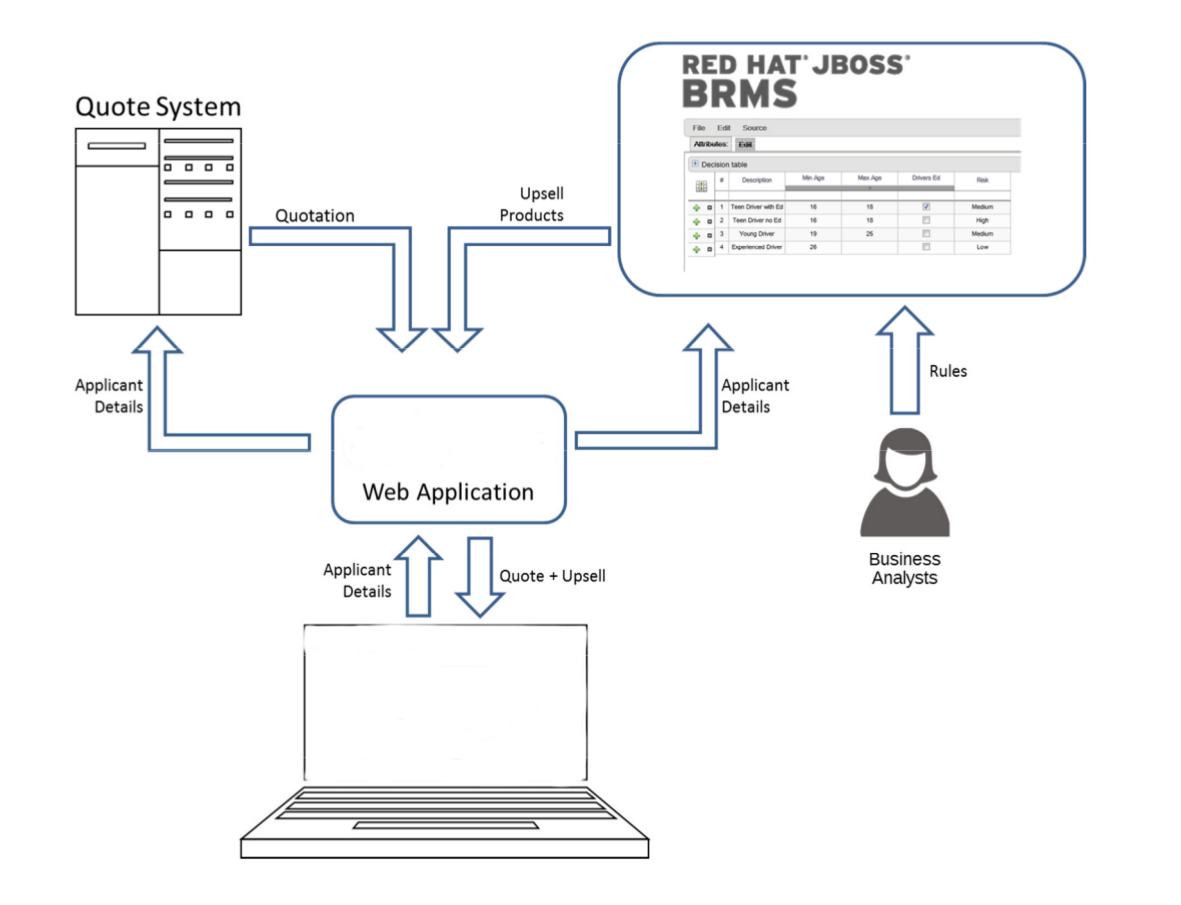Chapter 1. Introduction
1.1. About Red Hat JBoss BRMS
Red Hat JBoss BRMS is an open source decision management platform that combines Business Rules Management and Complex Event Processing. It automates business decisions and makes that logic available to the entire business.
Red Hat JBoss BRMS uses a centralized repository where all resources are stored. This ensures consistency, transparency, and the ability to audit across the business. Business users can modify business logic without requiring assistance from IT personnel.
Business Resource Planner is included with this release.
Red Hat JBoss BRMS is supported for use with Red Hat Enterprise Linux 7 (RHEL7).
1.2. Use Case: Business Decision Management in the Insurance Industry with Red Hat JBoss BRMS
Red Hat JBoss BRMS comprises a high performance rule engine, a rule repository, easy to use rule authoring tools, and complex event processing rule engine extensions. The following use case describes how these features of JBoss BRMS are implemented in insurance industry.
The consumer insurance market is extremely competitive, and it is imperative that customers receive efficient, competitive, and comprehensive services when visiting an online insurance quotation solution. An insurance provider increased revenue from their online quotation solution by upselling relevant, additional products during the quotation process to the visitors of the solution.
The diagram below shows integration of JBoss BRMS with the insurance provider’s infrastructure. This integration is fruitful in such a way that when a request for insurance is processed, JBoss BRMS is consulted and appropriate additional products are presented with the insurance quotation.
Figure 1.1. JBoss BRMS Use Case: Insurance Industry Decision Making
JBoss BRMS provides the decision management functionality, that automatically determines the products to present to the applicant based on the rules defined by the business analysts. The rules are implemented as decision tables, so they can be easily understood and modified without requiring additional support from IT.
1.3. Assets
Anything that can be stored as a version in the artifact repository is an asset. This includes rules, packages, business processes, decision tables, fact models, and DSLs.
Rules
Rules provide the logic for the rule engine to execute against. A rule includes a name, attributes, a 'when' statement on the left hand side of the rule, and a 'then' statement on the right hand side of the rule.
Business Rules
Business Rules define a particular aspect of a business that is intended to assert business structure or influence the behaviour of a business. Business Rules often focus on access control issues, pertain to business calculations and policies of an organization.
Business Processes
Business Processes are flow charts that describe the steps necessary to achieve business goals (see the Red Hat JBoss BRMS Business Process Management Guide for more details).
Projects
A project is a container for packages of assets (business processes, rules, work definitions, decision tables, fact models, data models, and DSLs) that lives in the Knowledge Repository. It is this container that defines the properties of the KIE Base and KIE Session that are applied to its content. In the GUI, you can edit these entities in the Project Editor.
If an asset, such as a Process or Rule definition, is not placed in a package with a Project, it cannot be deployed. Therefore, make sure to organize your assets in packages. Also note, that the name of the package must be identical with the KIE Session name.
As a project is a Maven project, it contains the Project Object Model file (pom.xml) with information on how to build the output artifact. It also contains the Module Descriptor file, kmodule.xml, that contains the KIE Base and KIE Session configuration for the assets in the project.
Packages
Packages are deployable collections of assets. Rules and other assets must be collected into a package before they can be deployed. When a package is built, the assets contained in the package are validated and compiled into a deployable package.
Domain Specific Languages
A domain specific languages, or DSL, is a rule language that is dedicated to the problem domain.
Decision Tables
Decision Tables are collections of rules stored in either a spreadsheet or in the JBoss BRMS user interface as guided decision tables.
Data Model
Data models are a collection of facts about the business domain. The rules interact with the data model in rules-based applications.
